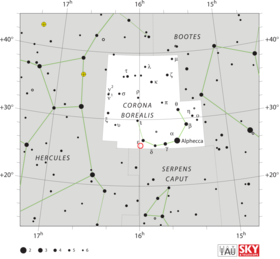T Coronae Borealis
| Observation data Epoch J2000 Equinox J2000 | ||
|---|---|---|
| Constellation | Corona Borealis | |
| Right ascension | 15h 59m 30.1622s[1] | |
| Declination | 25° 55′ 12.613″[1] | |
| Apparent magnitude (V) | 2.0–10.8[2] | |
| Characteristics | ||
| Evolutionary stage | Red giant + white dwarf | |
| Spectral type | M3III+p[3] | |
| Variable type | recurrent nova[2]
| |
Inclination (i) 67[8]° | | |
| Details | ||
| Red giant | ||
| Mass | 1.12[6] M☉ | |
| Radius | 75[8] R☉ | |
| Luminosity | 655[9] L☉ | |
| Surface gravity (log g) | 2.0[10] cgs | |
| Temperature | 3,600[10] K | |
| White dwarf | ||
| Mass | 1.37[6] M☉ | |
| Luminosity | ~100[8] L☉ | |
| J15593015+2555126 | ||
| Database references | ||
| SIMBAD | data | |
T Coronae Borealis (T CrB), nicknamed the Blaze star, is a recurrent nova in the constellation Corona Borealis.[11] It was first discovered in outburst in 1866 by John Birmingham,[12] although it had been observed earlier as a 10th magnitude star.[13] It may have been observed in 1217 and in 1787 as well.[14][15] It is expected to undergo an outburst again in 2024.
Description
T CrB normally has a magnitude of about 10, which is near the limit of typical binoculars. Outbursts have been seen twice, reaching magnitude 2.0 on May 12, 1866 and magnitude 3.0 on February 9, 1946,[16] although a more recent paper shows the 1866 outburst with a possible peak range of magnitude 2.5 ± 0.5.[17] Even when at peak magnitude of 2.5, this recurrent nova is dimmer than about 120 stars in the night sky.[18] It is sometimes nicknamed the Blaze Star.[19]
T CrB is a
The two components of the system orbit each other every 228 days. The orbit is almost circular and is inclined at an angle of 67°. The stars are separated by 0.54 AU.[6]
2016–present activity
On 20 April 2016, the Sky & Telescope website reported a sustained brightening since February 2015 from magnitude 10.5 to about 9.2. A similar event was reported in 1938, followed by another outburst in 1946.[22] By June 2018, the star had dimmed slightly but still remained at an unusually high level of activity. In March or April 2023, it dimmed to magnitude 12.3.[23] A similar dimming occurred in the year before the 1946 outburst, indicating that it will likely erupt between April and September 2024.[24]
References
- ^ S2CID 1828208. A2.
- ^ Bibcode:2009yCat....102025S.
- S2CID 119387088.
- ^ .
- ^ S2CID 203593955.
- ^ doi:10.1086/301260.
- ^ S2CID 3000175.
- S2CID 16087253.
- ^ S2CID 106406607.
- ^ Andrews, Robin George (8 March 2024). "The Night Sky Will Soon Get 'a New Star.' Here's How to See It. - A nova named T Coronae Borealis lit up the night about 80 years ago, and astronomers say it's expected to put on another show in the coming months". The New York Times. Archived from the original on 8 March 2024. Retrieved 9 March 2024.
- doi:10.1086/125797.
- doi:10.1086/141446.
- ISSN 0021-8286.
- ^ Thompson, Joanna (September 15, 2023). "Evidence of mysterious 'recurring nova' that could reappear in 2024 found in medieval manuscript from 1217". Live Science. Retrieved 2024-03-21.
- doi:10.1086/145106.
- S2CID 119294221.
- ^ "Vmag<2.5". SIMBAD Astronomical Database. Retrieved 2010-06-25.
- ^ Gray, R. O. (2000). "34. Unusual Stellar Spectra III: two emission-line stars". A Digital Spectral Classification Atlas. California Institute of Technology.
- S2CID 119104759.
- S2CID 119078482.
- ^ "Is T CrB About to Blow its Top?". Sky & Telescope website. 20 April 2016. Retrieved 2017-08-06.
- ^ Schaefer, B.E.; Kloppenborg, B.; Waagen, E.O. "Announcing T CrB pre-eruption dip". AAVSO. American Association of Variable Star Observers. Retrieved 18 January 2024.
- ^ Todd, Ian. "T Coronae Borealis nova event guide and how to prepare". Sky at Night Magazine. BBC. Retrieved 18 March 2024.
Further reading
- Wallerstein, George; Tanya Harrison; Ulisse Munari; Andrew Vanture (11 May 2008). "The Metallicity and Lithium Abundances of the Recurring Novae T CrB and RS Oph". S2CID 106406607.
- R and T Coronae Borealis: Two Stellar Opposites Archived 2012-04-06 at the Wayback Machine at Sky & Telescope
External links
- http://www.daviddarling.info/encyclopedia/B/Blaze_Star.html
- AAVSO: Quick Look View of AAVSO Observations (get recent magnitude estimates for T CrB)


